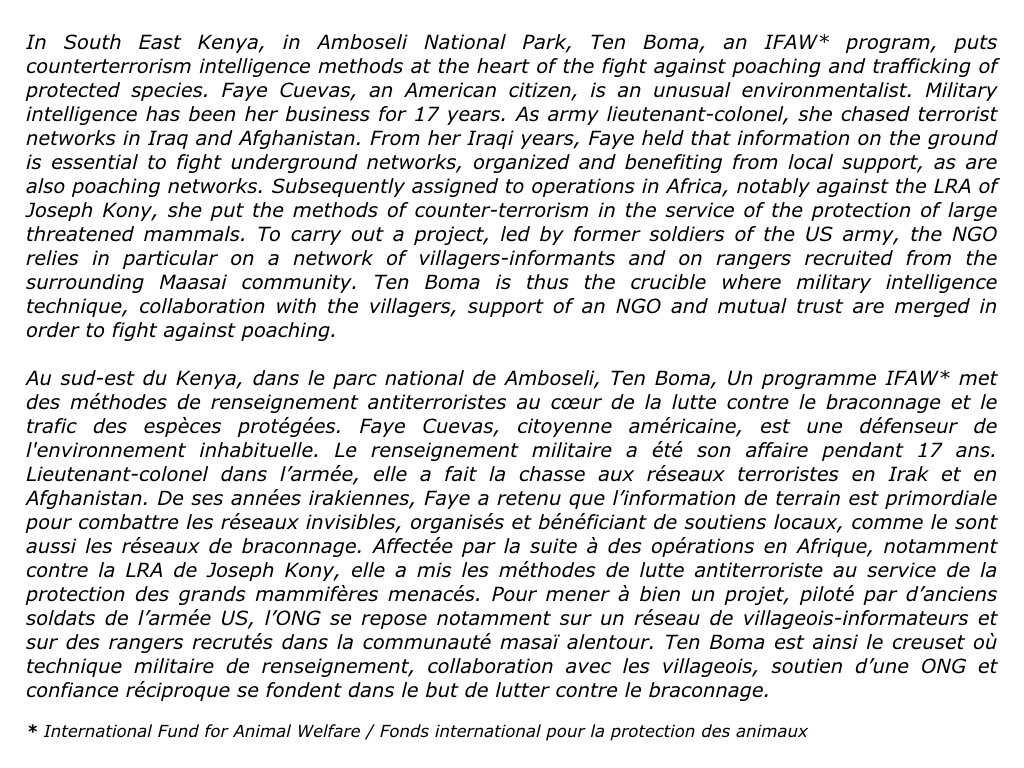
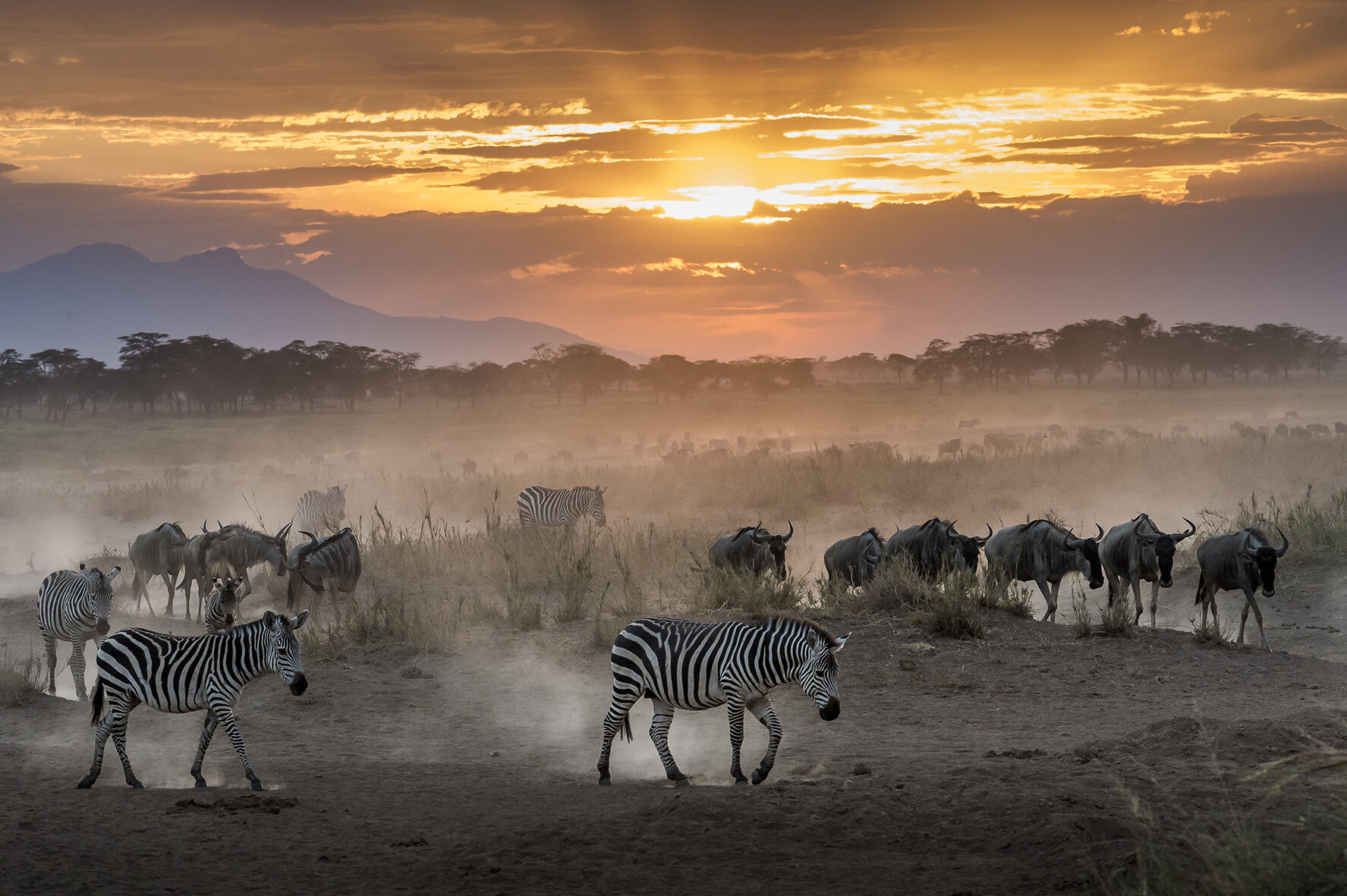
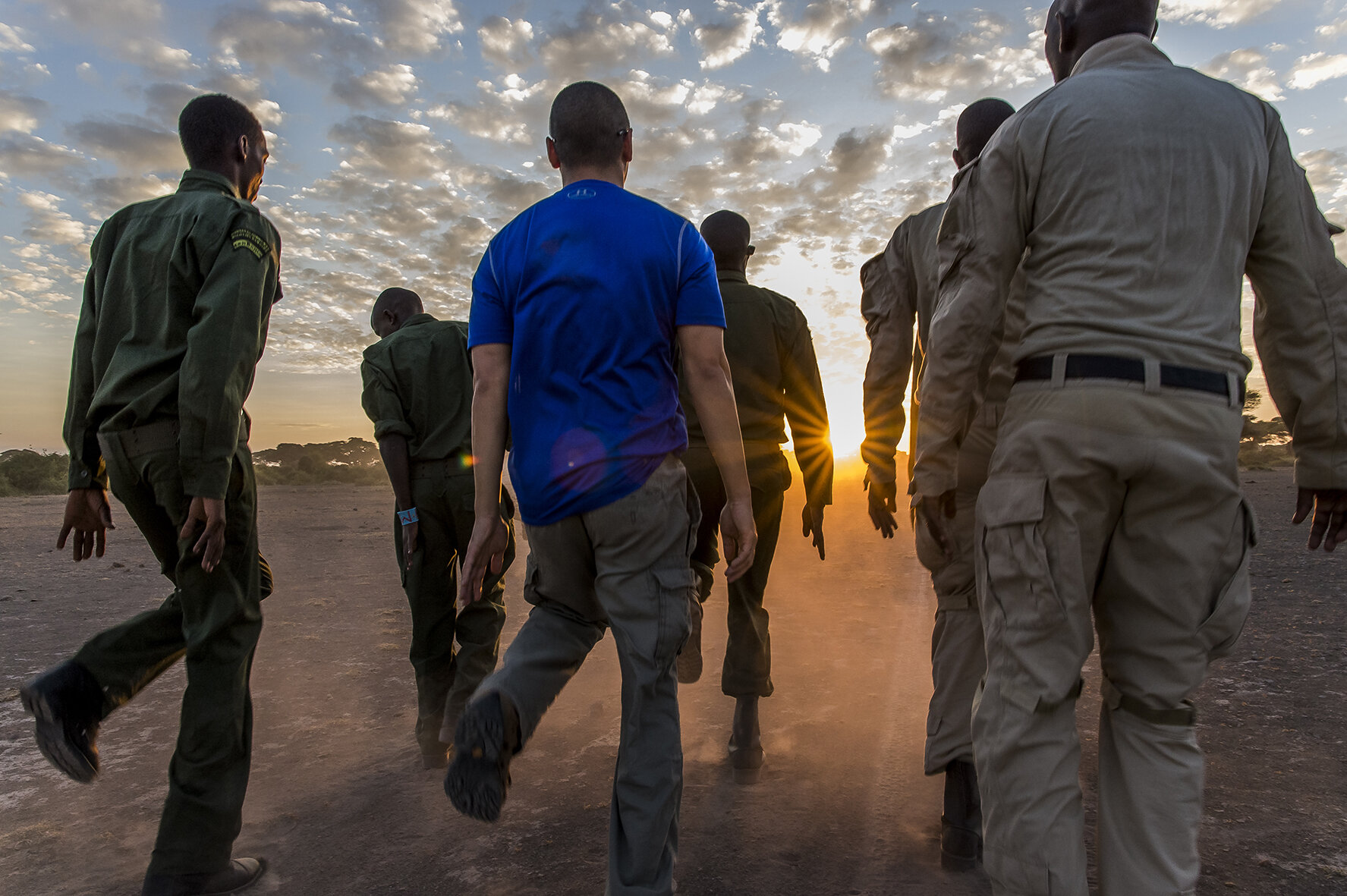


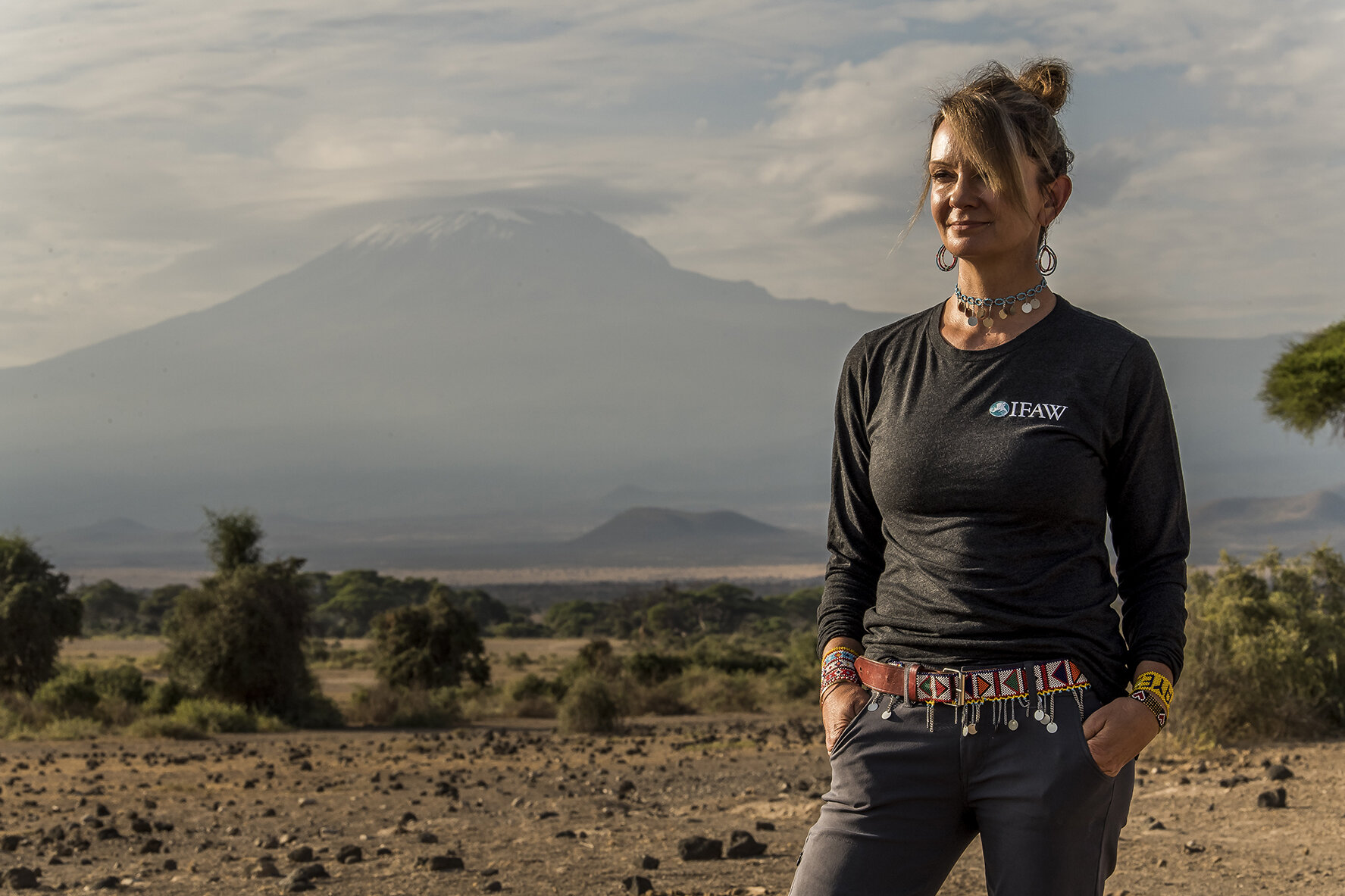

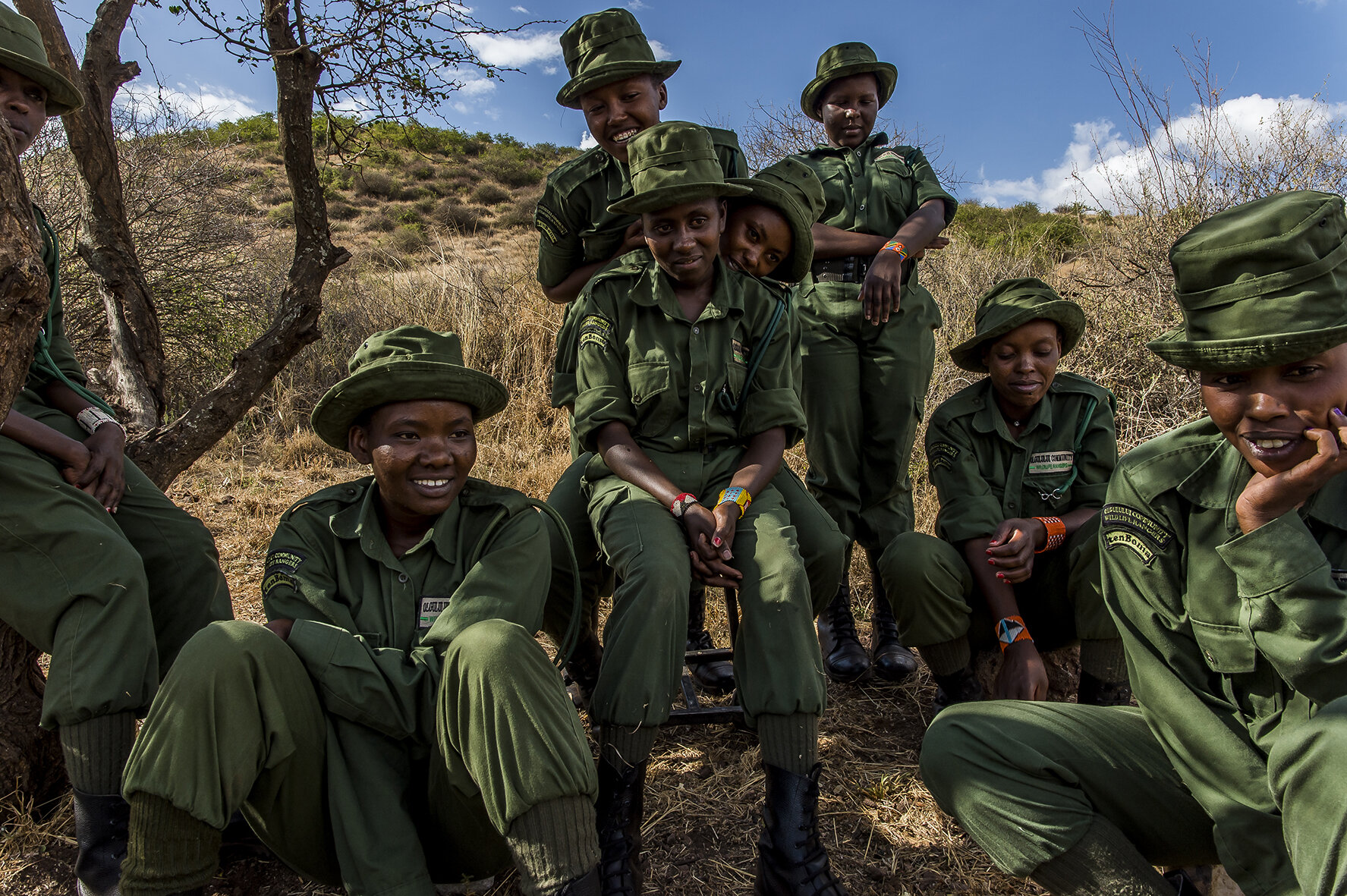

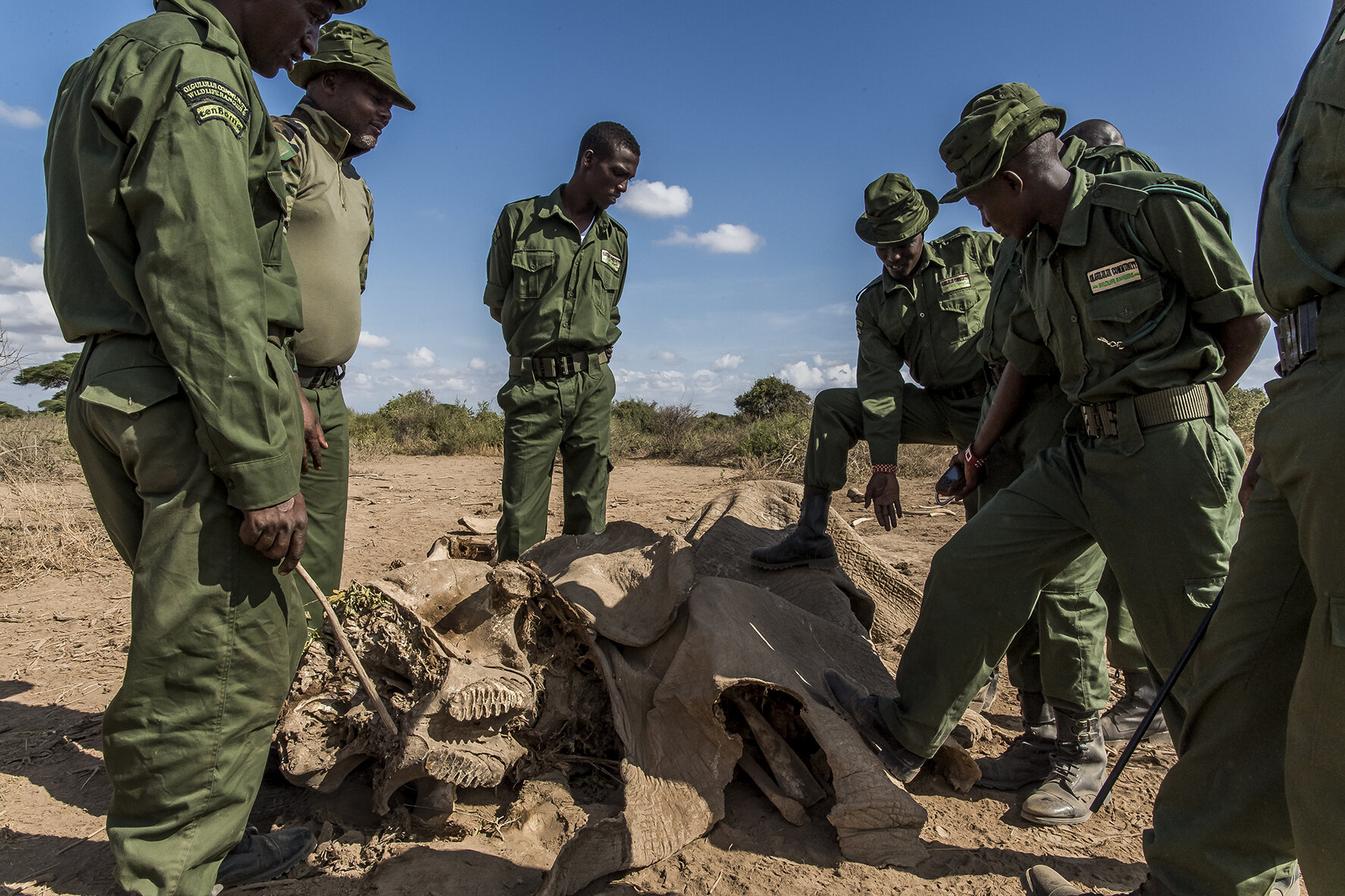

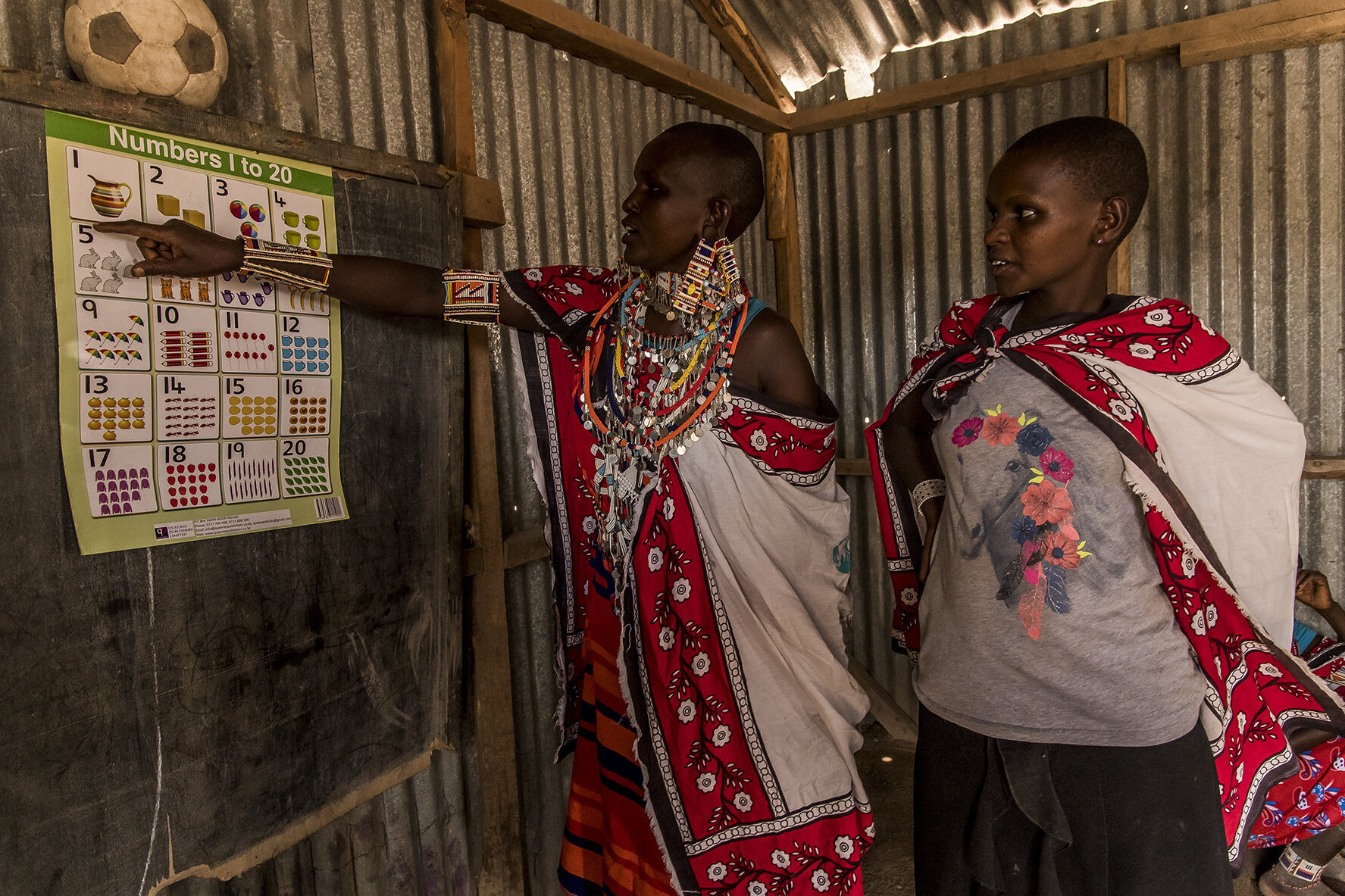
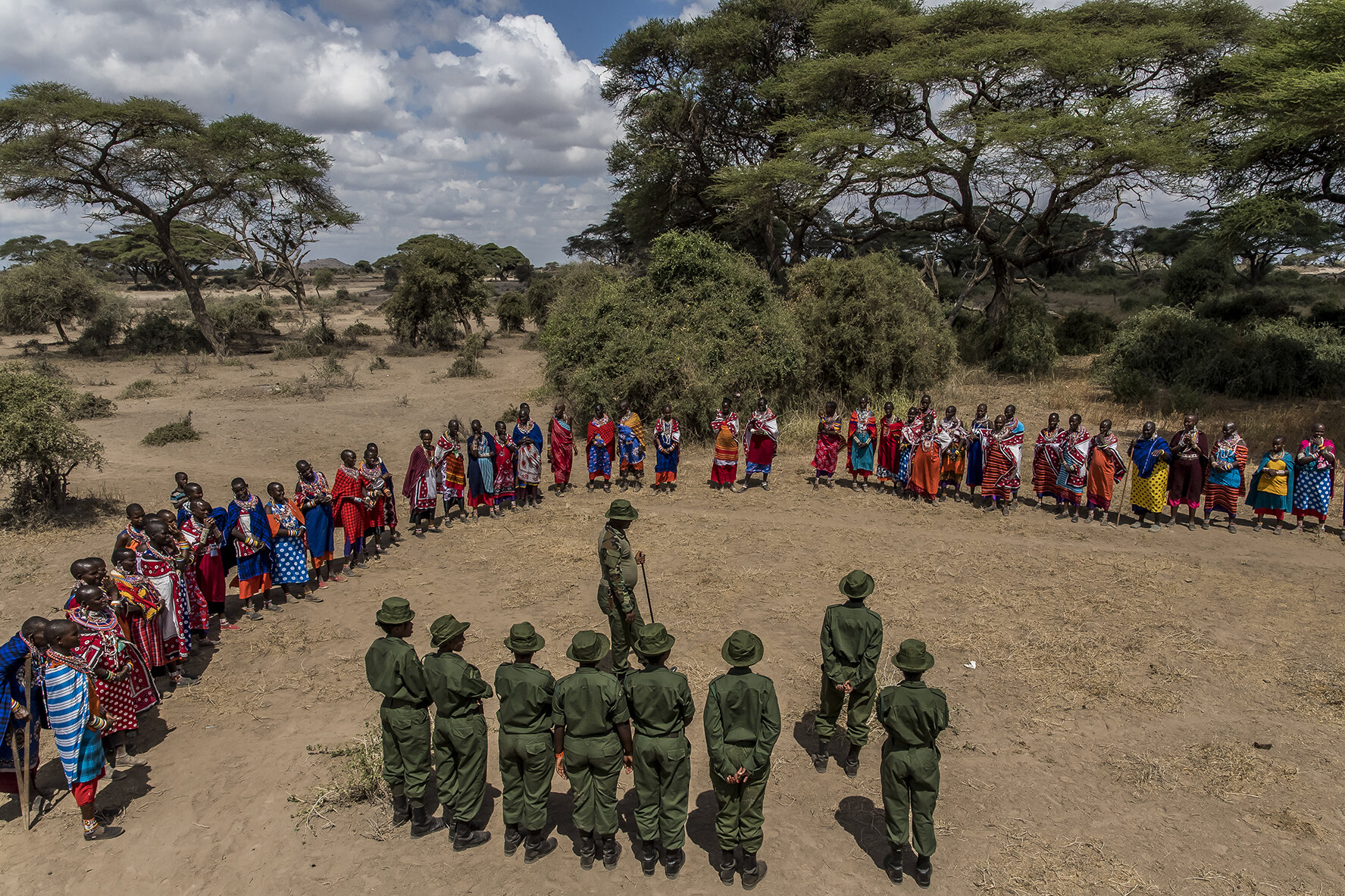
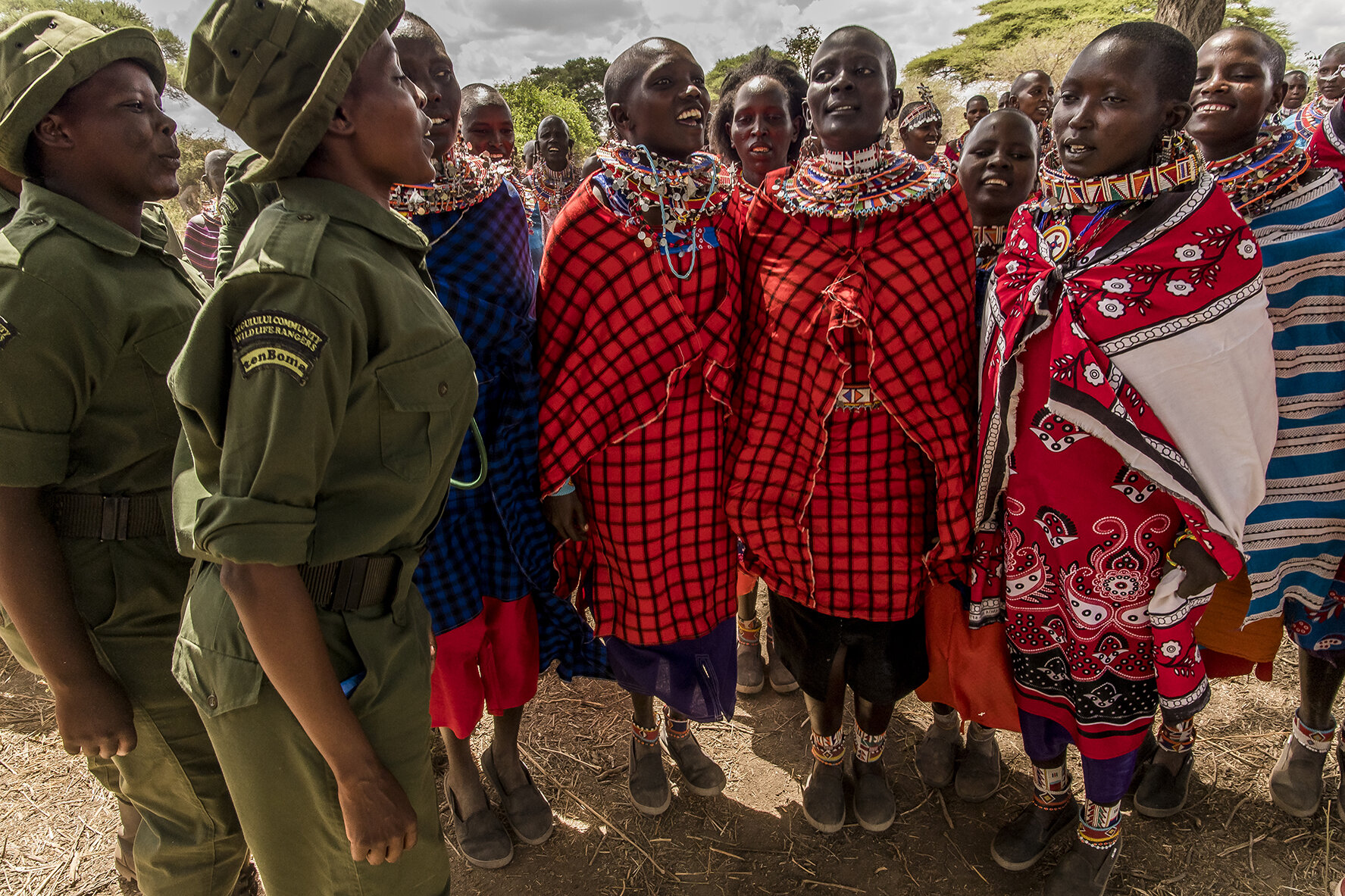
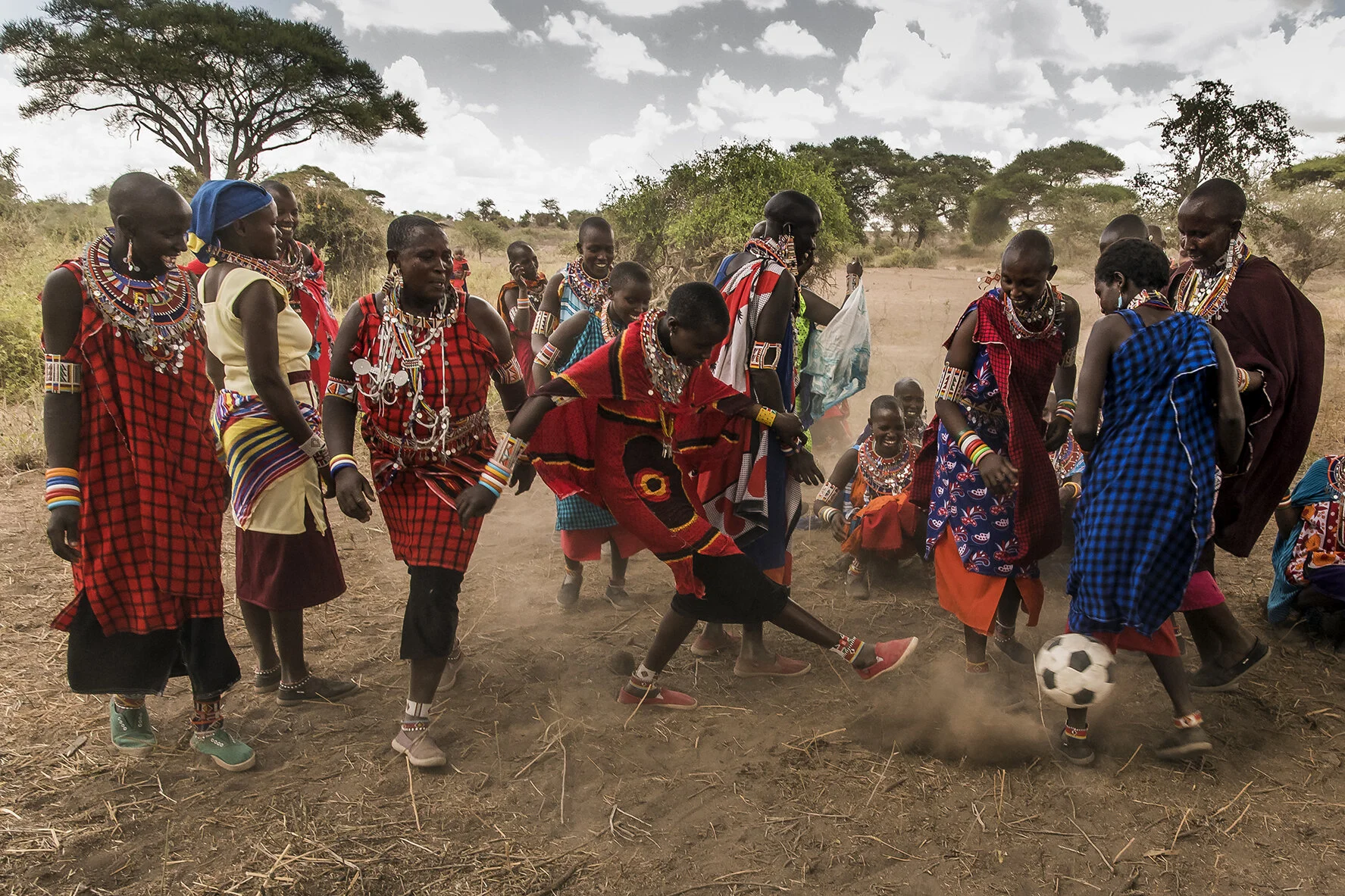

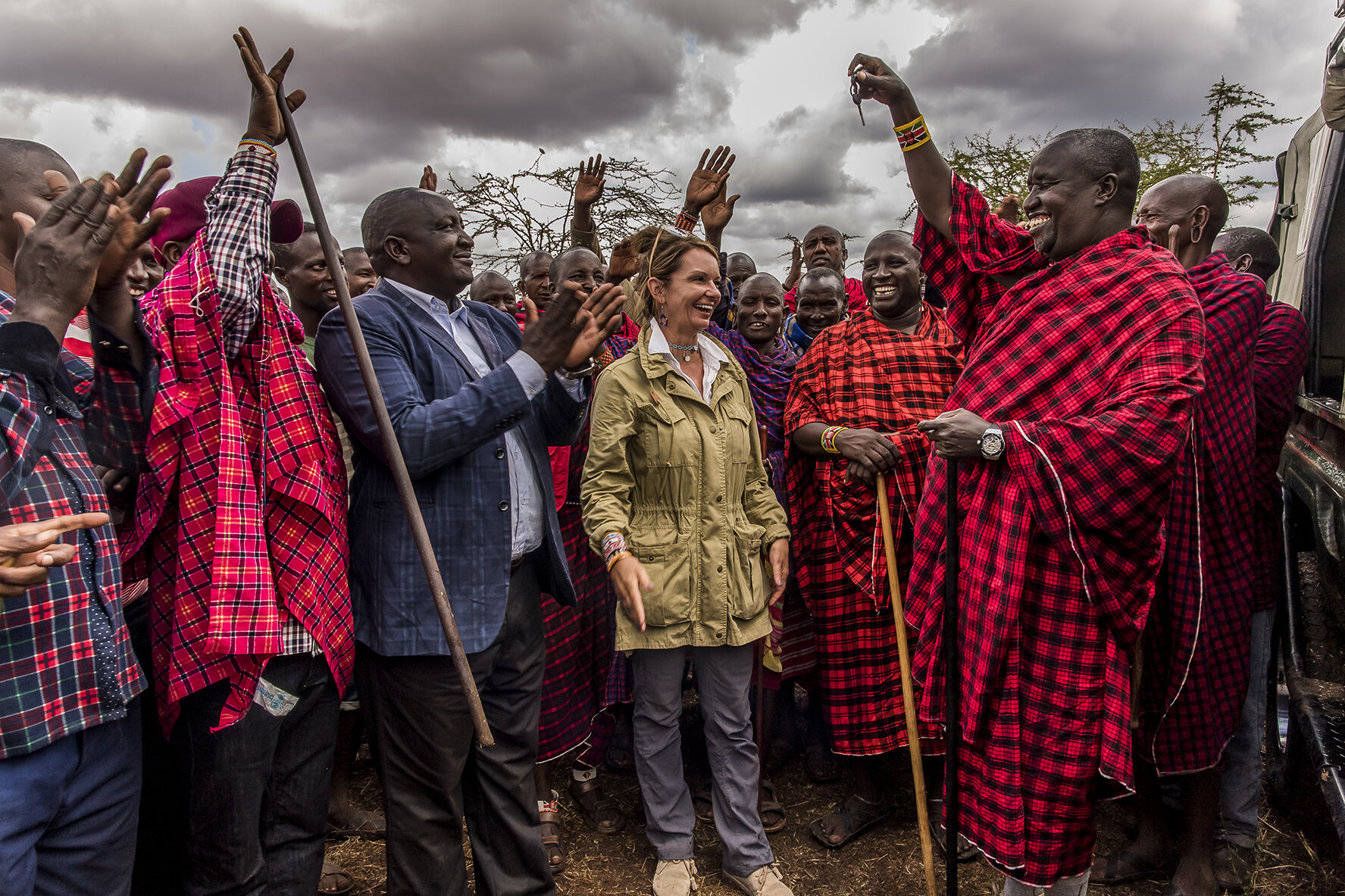
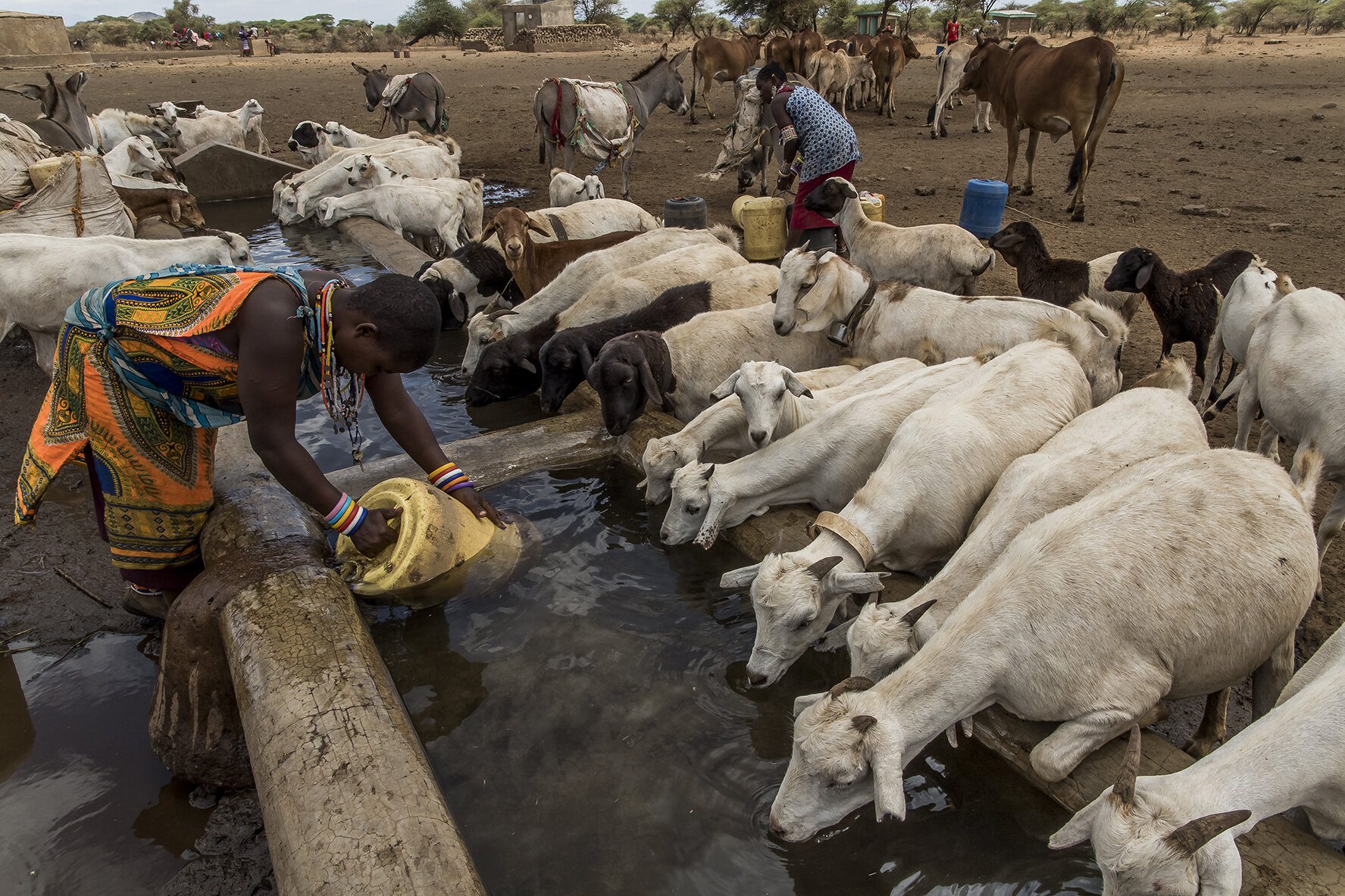
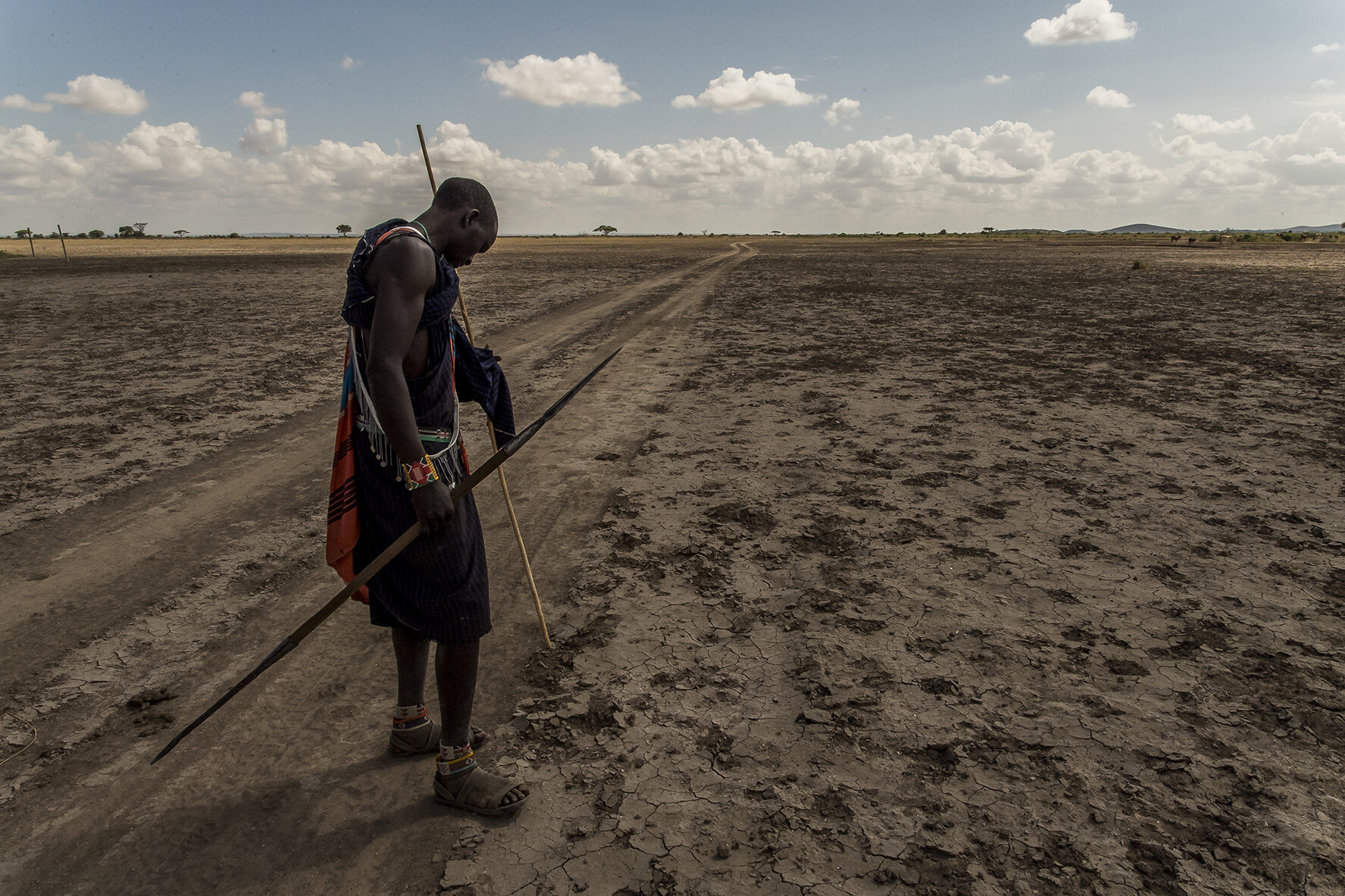
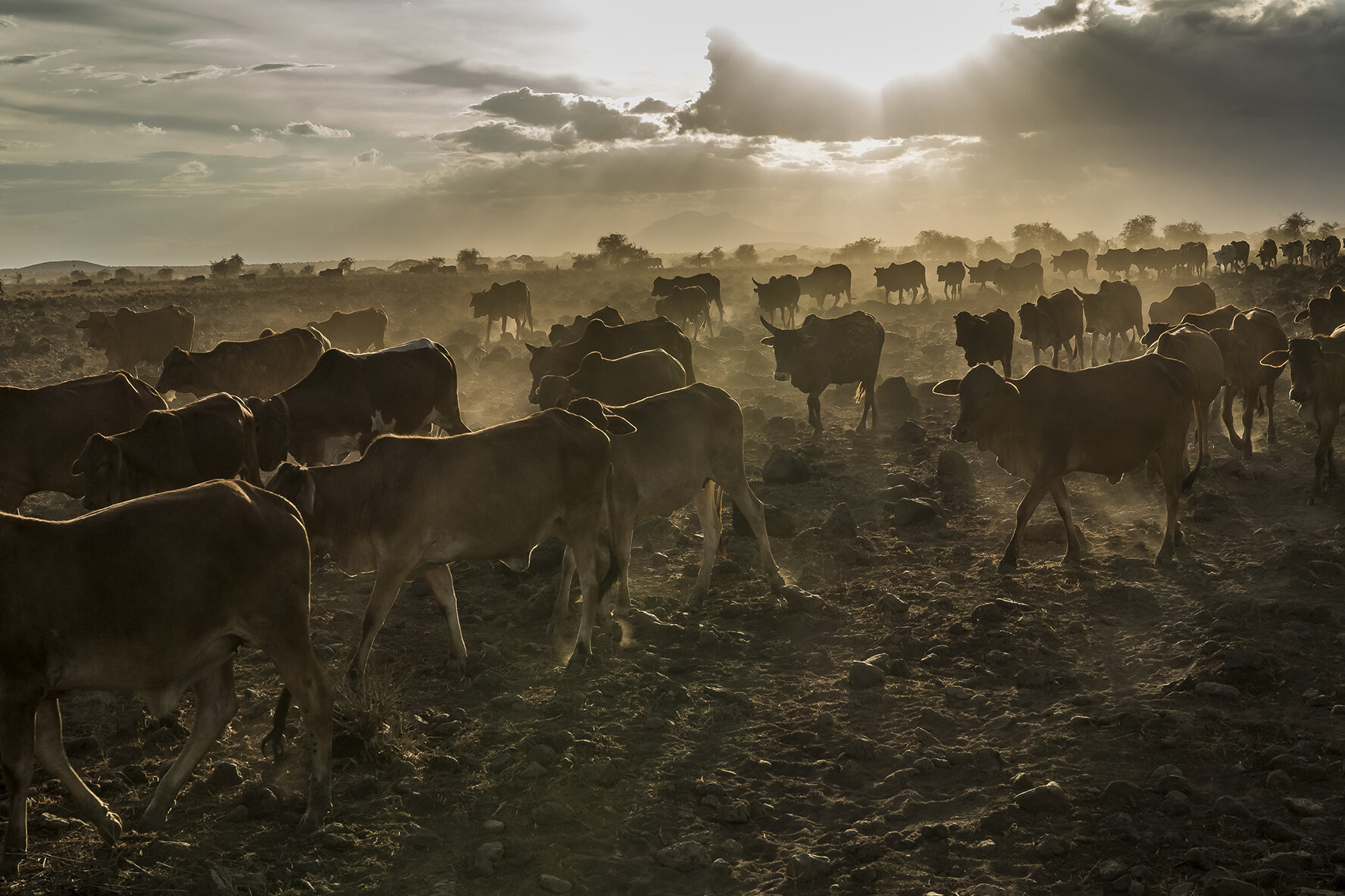
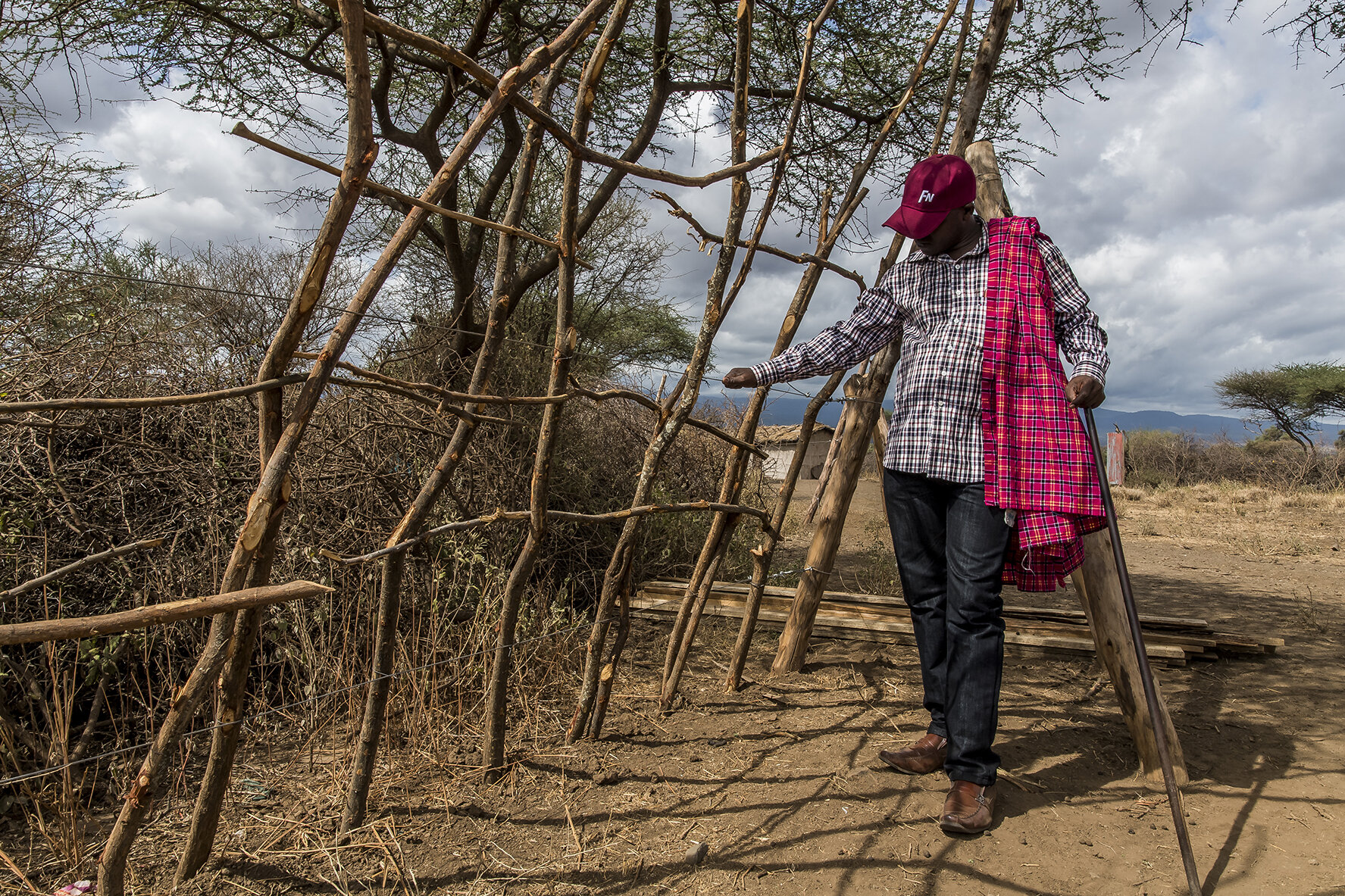
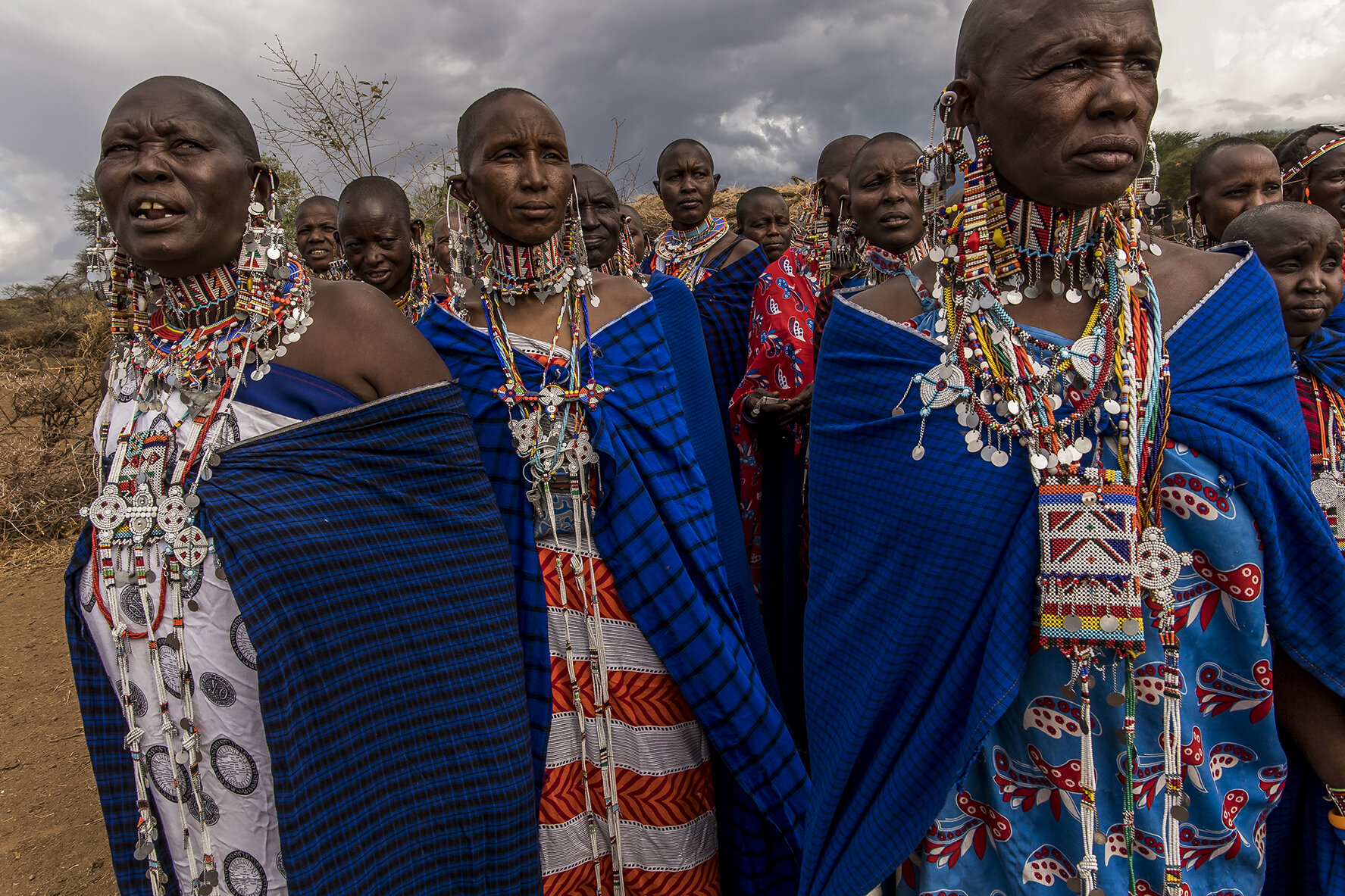

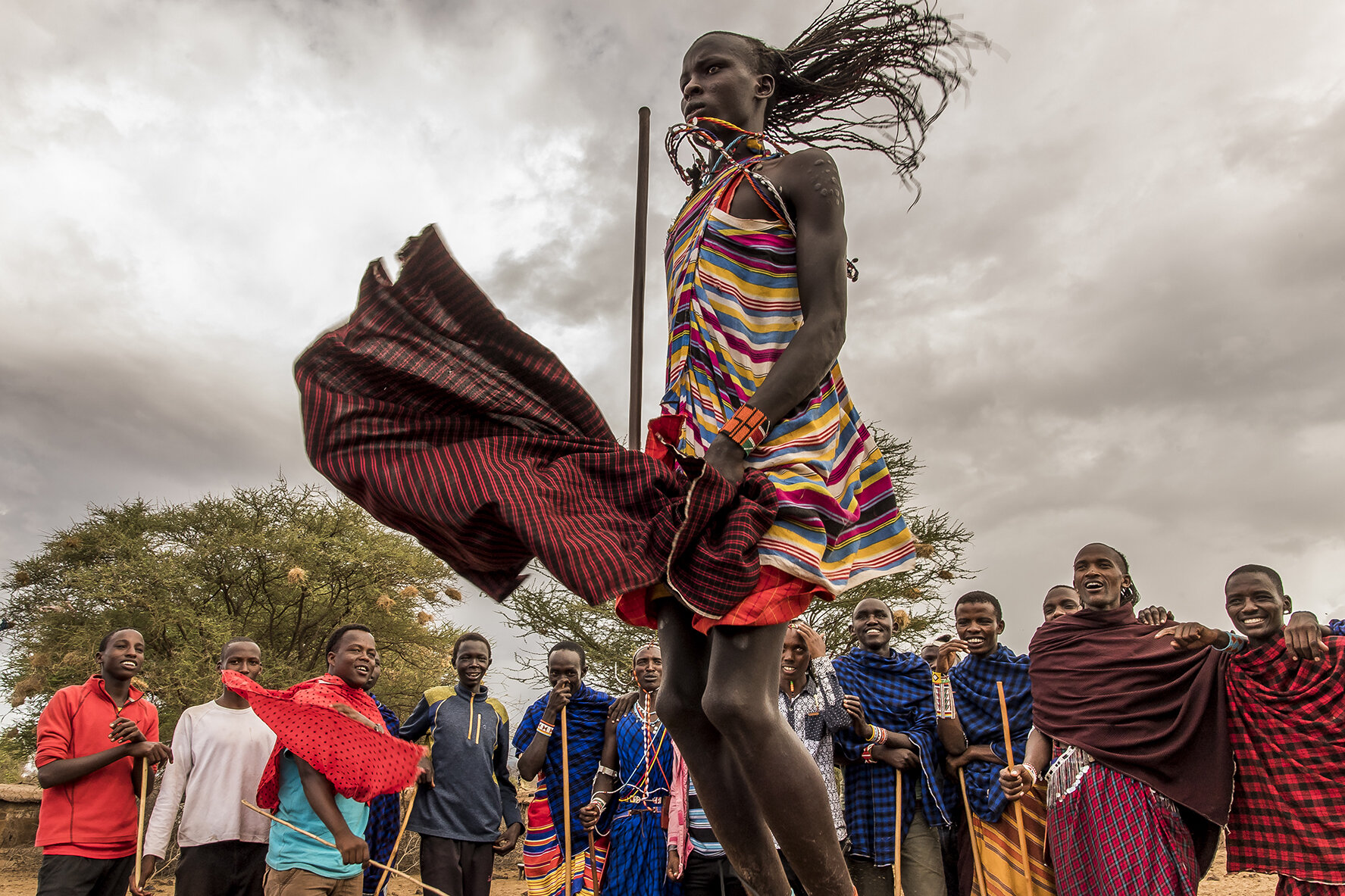
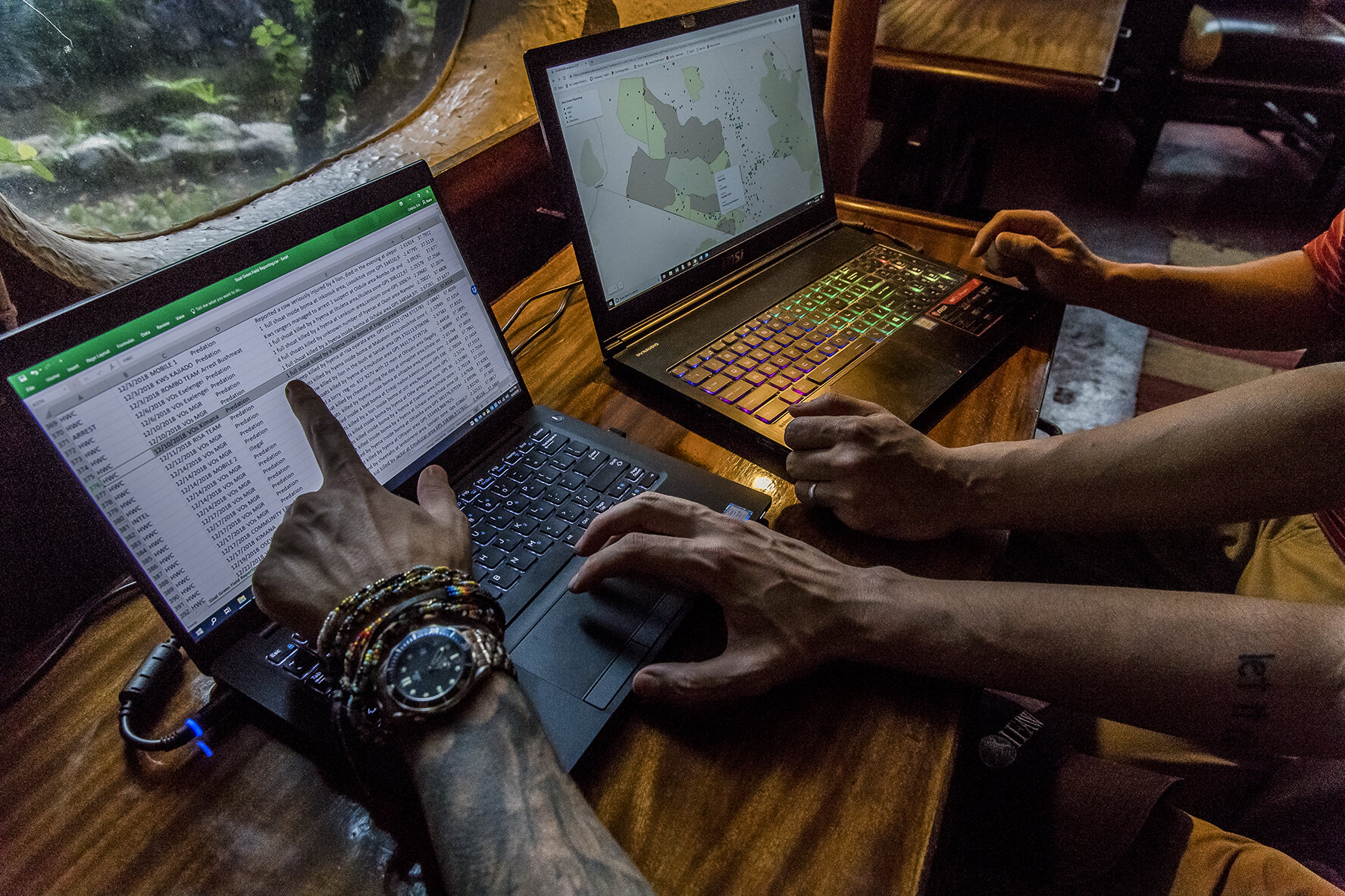
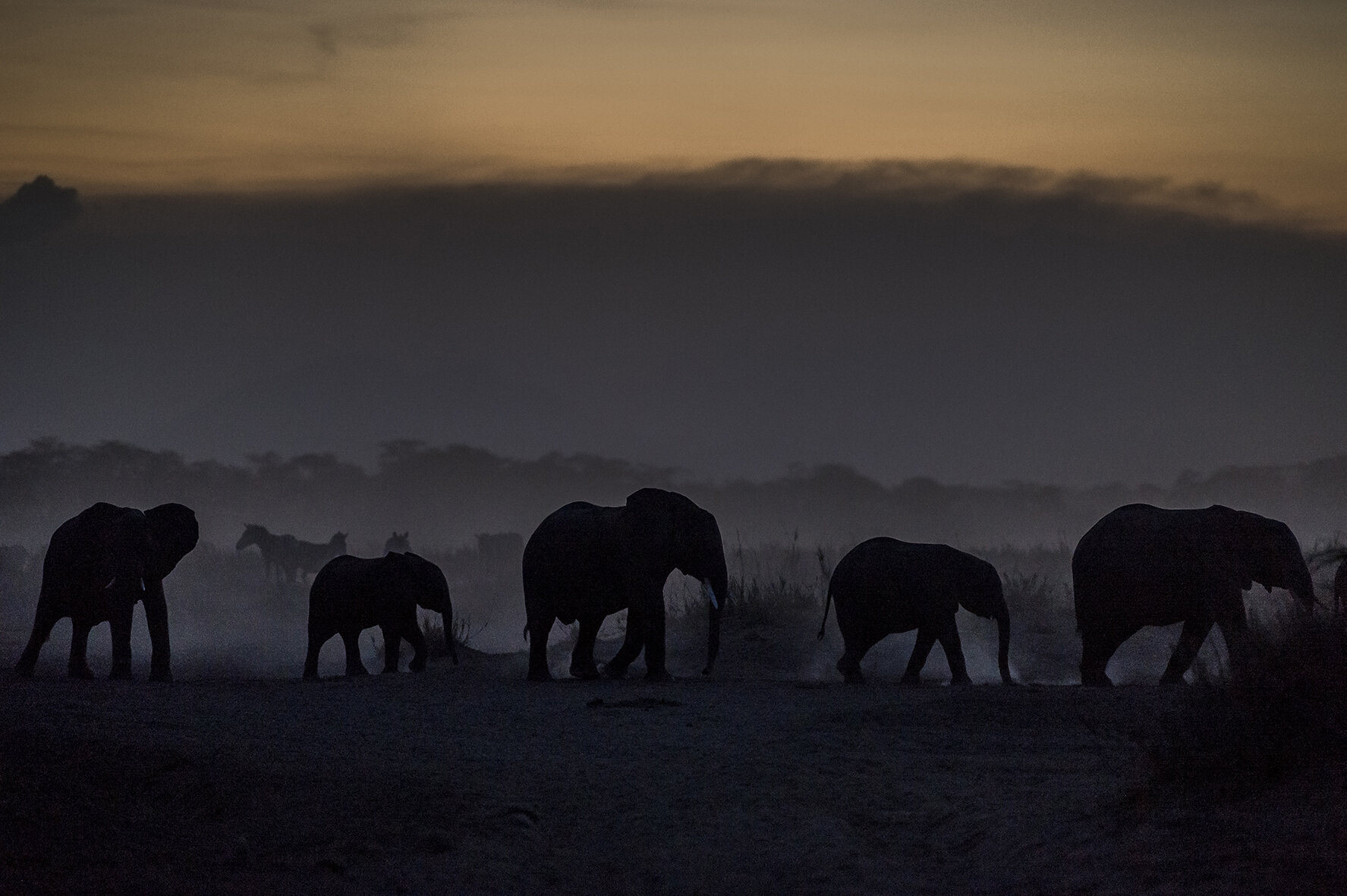
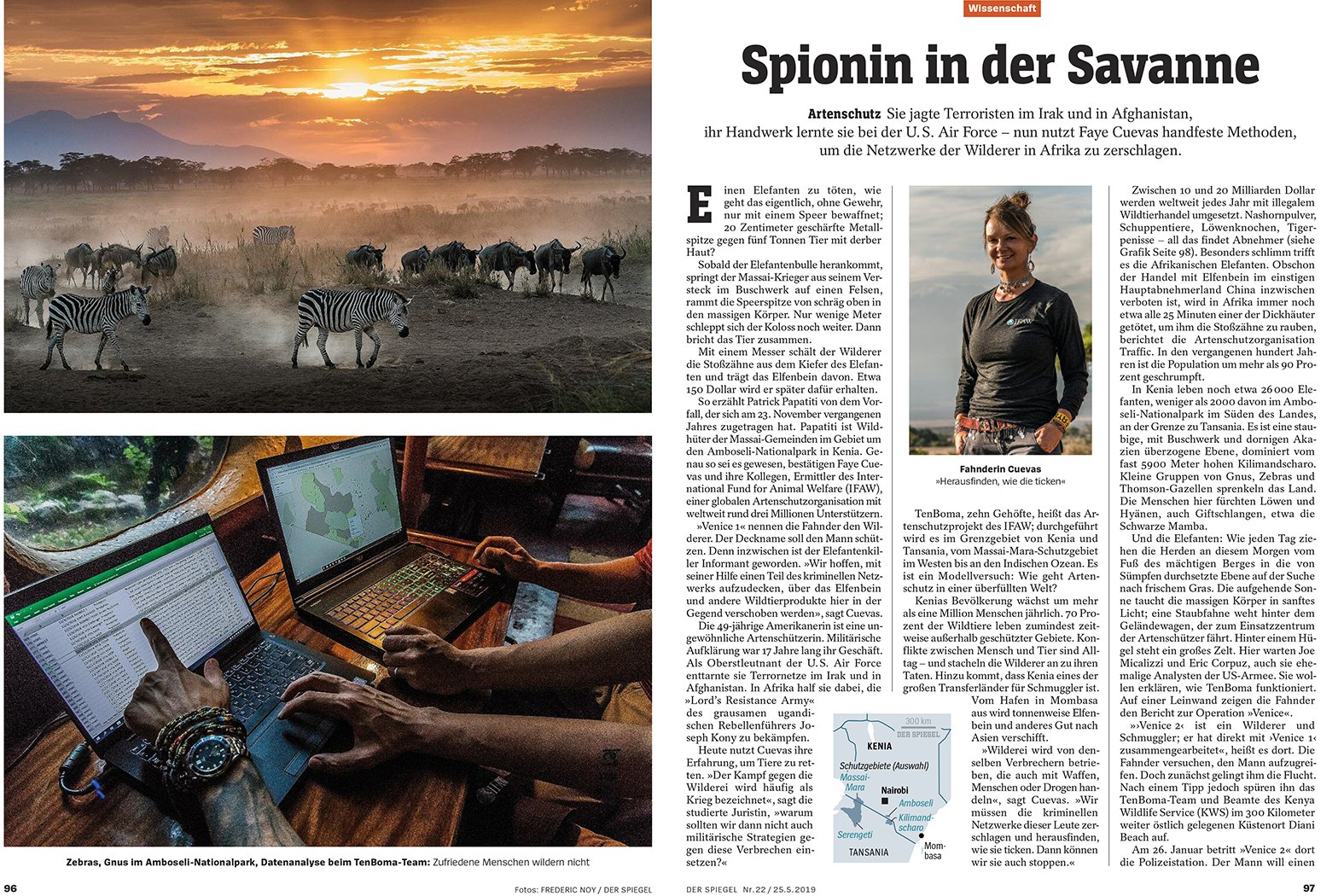
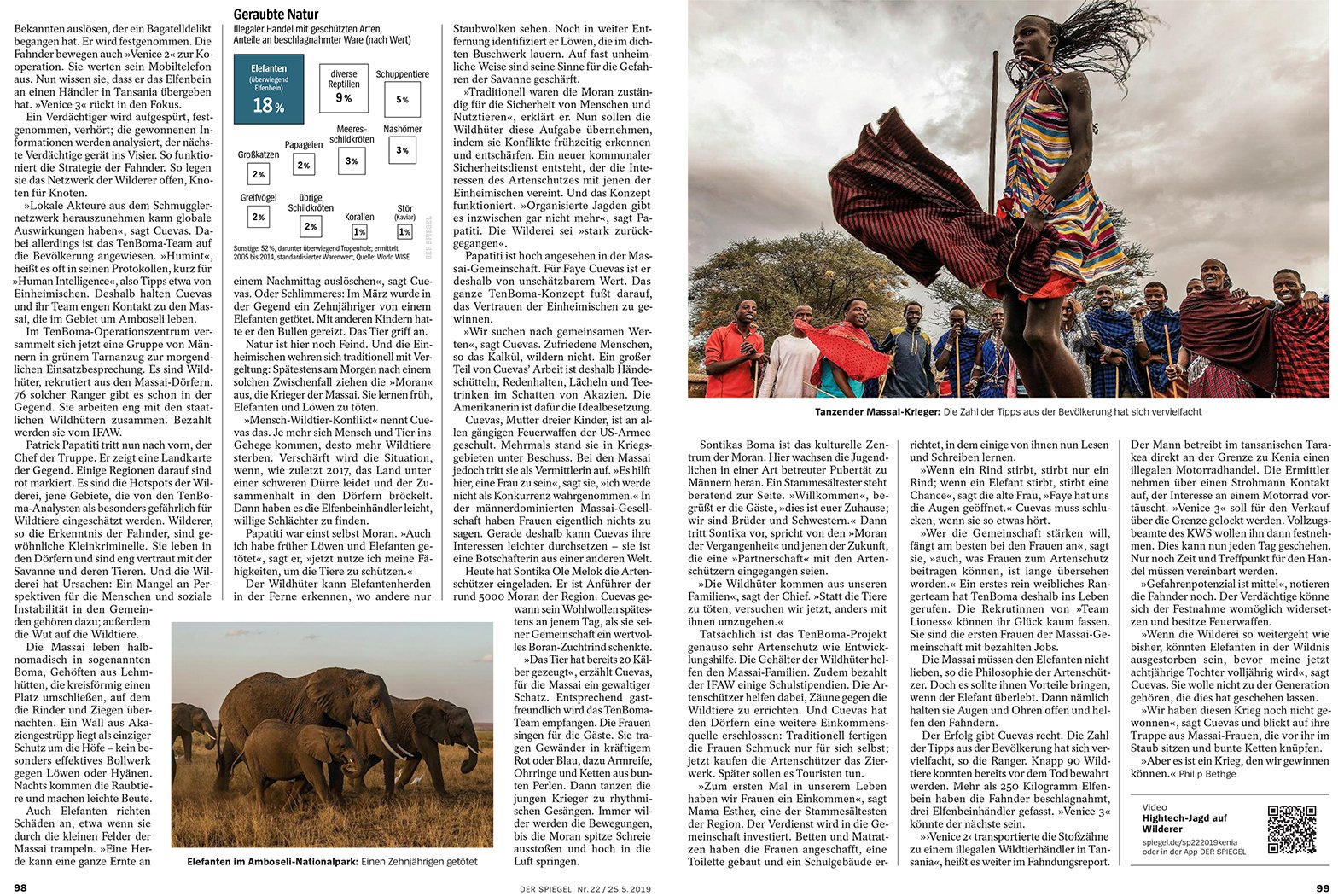

End of the day in Amboseli National Park, in south-eastern Kenya. Zebras and wildebeest return to the marshy plains near Kilimanjaro, to spend the night. 70% of wild animals live at least temporarily outside protected areas causing conflicts between humans and animals. In addition, Kenya is one of the main transit countries for poachers. Tons of ivory and other goods are shipped from the port of Mombasa to Asia.
Fin de journée dans le parc national d’Amboseli, au sud-est du Kenya. Des zèbres et des gnous regagnent les plaines marécageuses proche du Kilimanjaro, pour passer la nuit. 70% des animaux sauvages vivent au moins temporairement en dehors de zones protégées engendrant des conflits entre humains et animaux. De plus, le Kenya est un des principaux pays de transit pour les braconniers. Des tonnes d'ivoire et d'autres marchandises sont expédiées du port de Mombasa vers l'Asie.

In the early morning hours, in Amboseli Park, a group of « Ten Boma » project rangers trained, that day, with Eric Corpuz, a former US military analyst, who worked on the intelligence side of the project.
Au petit matin, dans le parc d’Amboseli, un groupe de rangers du projet « Ten Boma » s’entraîne en compagnie, ce jour-là, de Eric Corpuz un ancien analyste de l'armée américaine, cheville ouvrière du volet renseignement du projet.

About 26,000 elephants still live in Kenya, including less than 2,000 in Amboseli National Park in the southeast of the country, on the border with Tanzania, a dusty plain covered with bushes and thorny acacia trees, dominated by the Kilimanjaro, almost 5,900 meters high.
Environ 26 000 éléphants vivent encore au Kenya, dont moins de 2 000 dans le parc national d'Amboseli au sud-est du pays, à la frontière avec la Tanzanie, une plaine poussiéreuse recouverte de buissons et d'acacias épineux, dominée par le Kilimandjaro, haut de près de 5900 mètres.

A herd of elephants roams the plain in front of Kilimanjaro, located in Tanzania, in search of fresh grass. Between $10 to $20 billion is spent annually on illegal wildlife trafficking to sell rhino horn powder, pangolin, lion bone, tiger penis. African elephants are particularly affected. Although the ivory trade is now banned in China, the main market, a pachyderm is always killed about every 25 minutes to steal its tusks, reports the wildlife conservation organization Traffic. Over the past 100 years, the population has declined by more than 90%.
Un troupeau d’éléphants se déplace dans la plaine devant le Kilimanjaro, situé en Tanzanie, à la recherche d'herbe fraîche. Entre 10 et 20 milliards de dollars sont dépensés par an, dans le monde pour le trafic illégal d'espèces sauvages pour proposer à l’acheteur poudre de corne de rhinocéros, pangolins, os de lion, pénis de tigre. Les éléphants d'Afrique sont particulièrement touchés. Bien que le commerce de l'ivoire soit désormais interdit en Chine, ex principal marché, un pachyderme est toujours tué environ toutes les 25 minutes pour voler ses défenses, rapporte l'organisation de conservation de la faune Traffic. Au cours des cent dernières années, la population a diminué de plus de 90%.

Faye Cuevas, investigator for the International Fund for Animal Welfare (IFAW), a global species protection organization with approximately three million supporters worldwide. The American is an unusual defender of the environment. Military intelligence has been his business for 17 years. As a Lieutenant-Colonel in the United States Army, she chased terrorist networks in Iraq and Afghanistan.
From his years in Iraq, Faye held that information on the ground is essential to combat invisible networks, organized and benefiting from local support, as are also poaching networks. Subsequently assigned to operations in Africa, in particular against the LRA of Joseph Kony, she decided to put the methods of counter-terrorism in the service of the protection of large threatened mammals.
"Poaching is led by the same criminals who traffick weapons, people or drugs," says Cuevas. We need to break down these criminal networks and find out what motivates them. Then we can stop them. «
Faye Cuevas, enquêtrice du Fonds international pour la protection des animaux (IFAW), une organisation mondiale de protection des espèces qui compte environ trois millions de sympathisants dans le monde. L'Américaine est un défenseuse de l'environnement inhabituelle. Le renseignement militaire a été son affaire pendant 17 ans. En tant que lieutenant-colonel de l’armée américaine, elle a fait la chasse aux réseaux terroristes en Irak et en Afghanistan.
De ses années en Irak, Faye a retenu que l’information de terrain est primordiale pour combattre les réseaux invisibles, organisés et bénéficiant de soutiens locaux, comme le sont aussi les réseaux de braconnage. Affectée par la suite à des opérations en Afrique, notamment contre la LRA de Joseph Kony, elle a décidé de mettre les méthodes de lutte antiterroriste au service de la protection des grands mammifères menacés.
« Le braconnage est dirigé par les mêmes criminels qui trafiquent armes, personnes ou drogues", explique Cuevas. Nous devons briser ces réseaux criminels et découvrir ce qui les motivent. Ensuite, nous pourrons les arrêter. »

A rangers post from IFAW (International Fund for Animal Welfare), in the plain of Amboseli national park, in Kenya, facing Tanzania. Animal reserve in the 1940s, it was not until 1974 that Amboseli became a national park. In fact, a long conflict pitted the government against the Masai for decades, who had always lived in the region. First expelled, the latter ended up finding a compromise with the State, which granted them land, which allowed the creation of the park.
Un poste de rangers de IFAW (Fonds international pour la protection des animaux), dans la plaine du parc national de Amboseli, au Kenya, face à la Tanzanie. Réserve animalière dans les années 1940, il fallut attendre 1974 pour qu’Amboseli devienne un parc national. En effet un long conflit opposa pendant des décennies le gouvernement aux Masaïs installés depuis toujours dans la région. D'abord expulsés, ces derniers finirent par trouver un compromis avec l'Etat, qui leur accorda des terres, ce qui permit la création du parc.

Faye Cuevas, main coordinator of the “Ten Boma” project in Amboseli National Park: « If you want to strengthen the community, it is best to start with the women. The way in which women can contribute to the protection of species has long been overlooked. » « TenBoma » has created a first team of purely female rangers: the Lionesses. Recruits cannot believe in their luck. They are the first women in the Masai community to have a paid job.
Faye Cuevas, principal animatrice du projet « Ten Boma » dans le parc national de Amboseli : «Si vous voulez renforcer la communauté, il est préférable de commencer par les femmes. La manière dont les femmes peuvent contribuer à la protection des espèces a longtemps été ignoré.» « TenBoma » a créé une une première équipe de rangers purement féminine : les Lionnes. Les recrues peinent à croire en leur chance. Ce sont les premières femmes de la communauté Masai à avoir un emploi rémunéré.

Two rangers from the “Ten Boma” project enter the GPS coordinates collected during the morning patrol, in the database,. "Ten Boma" (the boma is the Masai village), is the conservation project of IFAW (International Fund for Animal Welfare) which operates in the border region of Kenya and Tanzania, of the Masai conservation area Mara in the west to the Indian Ocean. This name is inspired by the traditional belief that ten bomas are safe if they watch over each other.
Deux rangers du projet « Ten Boma » entrent dans la base de données, les coordonnée GPS récoltés lors de la patrouille du matin. « Ten Boma » (le boma est le village Masaï), est le projet de conservation d’IFAW (Fonds international pour la protection des animaux) qui fonctionne dans la région frontalière du Kenya et de la Tanzanie, de la zone de conservation du Masai Mara à l'ouest jusqu'à l'océan Indien. Ce nom est inspiré de la croyance traditionnelle suivant laquelle dix bomas sont en sécurité s’ils veillent les uns sur les autres.

Patrick Papatiti (second from left), formerly Moran (Masai warrior) chats with IFAW wildlife protection officers around the dried-up corpse of an elephant in Tanzania, a few hundred meters from Kenya. These gamekeepers are recruited from the surrounding villages and Masai community, on the Kenyan side. There are 76 such rangers in the region who work closely with the State Guards. They are paid by IFAW.
Patrick Papatiti (second à partir de la gauche), autrefois Moran (guerrier Masaï) discute avec des agents de protection de la faune de IFAW autour du cadavre desséché d’un éléphant, en Tanzanie, à quelques centaines de mètres du Kenya. Ces gardiens de chasse sont recrutés dans les villages et la communauté Masaï des environs, côté Kenyan. Il y a 76 rangers de ce type dans la région qui travaillent en étroite collaboration avec les gardes d'État. Ils sont rémunérés par l’IFAW.

Thanks to the sale of handcrafted jewelry, "for the first time in our lives, we women have an income" exclaims Mama Esther, one of the Masai tribal elders in the region. The revenues are invested in the community. Women buy beds and mattresses, build toilets and a school building in which some learn to read and write.
Grâce à la vente de bijoux artisanaux, « pour la première fois de notre vie, nous, les femmes, avons un revenu» s'exclame Mama Esther, l'une des aînées tribales Masaï de la région. Les revenus sont investis dans la communauté. Les femmes achètent des lits et des matelas, construisent des toilettes et un bâtiment scolaire dans lequel certaines apprennent à lire et à écrire.

A young Masai woman teaches a member of her tribe to recognize numbers, in the school building built by women and financed in particular by the sale of handcrafted jewelry that they make.
Une jeune Masaï apprend à une membre de sa tribu à reconnaître les chiffres, dans le bâtiment scolaire construite par les femmes et financé notamment par la vente des bijoux artisanaux qu’elles fabriquent.

The group of female rangers from IFAW (International Fund for Animal Welfare) is introduced to the community of Masai women by Patrick Papatiti, a renowned ex-Moran (warrior). One of the aims of these rangers is to gain the trust of women in order to obtain information, which is essential to combat poaching networks in the region. Traditionally, men do not converse with women.
Le groupe de rangers féminines de IFAW (Fonds international pour la protection des animaux) est présenté à la communauté des femmes Masaïs par Patrick Papatiti, un ex-Moran (guerrier) renommé. Un des objectifs de ces rangers est de gagner la confiance des femmes afin d’obtenir des renseignements, indispensables pour combattre les réseaux de braconnage dans la région. Traditionnellement, les hommes ne conversent pas avec les femmes.

During the official presentation of the Lionesses, the female rangers of "Ten Boma", women from the Masai community sing welcome songs and dance. The Lionesses answer them by joining them. In its fight against poaching networks, "Ten Boma" relies on the population and local councils, using « Humint", Human Intelligence.
Lors de la presentation officielle des Lionnes, les rangers féminines de « Ten Boma », des femmes de la communauté Masaï entonnent des chants de bienvenu et dansent. Les Lionnes leur répondent en se joignant à elles. Dans sa lutte contre les réseaux de braconnage, « Ten Boma » s'appuie sur la population et les conseils locaux, en usant de « Humint », « Human Intelligence ou renseignement humain ».

During the official presentation of the Lionesses, the female rangers of "Ten Boma", women from the Masai community engage in a frantic football game with the ball offered by the rangers. In its fight against poaching networks, the "Ten Boma" team relies on the population and local councils, using "Humint", "Human Intelligence ie human intelligence ».
Lors de la presentation officielle des Lionnes, les rangers féminines de « Ten Boma », des femmes de la communauté Masaï se lancent dans une partie de football effrénée avec le ballon offert par les rangers. Dans sa lutte contre les réseaux de braconnage, l'équipe de « Ten Boma » s'appuie sur la population et les conseils locaux, en usant de « Humint », « Human Intelligence cad renseignement humain ».

In a boma, young men are gathered to follow for several days, the rite of passage to adulthood allowing them to become "Morans", Masai warriors. They are visited by elders who share their wisdom and their teachings with them. Young people cannot leave Boma. Elderly women live with them, cooking for them.
Dans un boma, de jeunes hommes sont rassemblés pour suivre pendant plusieurs jours, le rite de passage à l’âge adulte leur permettant de devenir des « Morans », des guerriers Masaïs. Ils reçoivent la visite d’anciens qui leur font profiter de leur sagesse et de leur enseignement. Les jeunes ne peuvent quitter le Boma. Des femmes âgées vivent avec eux, cuisinant pour eux.

To the applause of the audience, one of the main leaders of the Masai community in the Amboseli region brandishes the keys to the 4x4 donated by Faye Cuevas, investigator of the International Fund for Animal Welfare (IFAW). The vehicle will be used by rangers from the community to patrol the park and surrounding areas for intelligence.
Sous les applaudissements de l’assistance, un des principaux leader de la communauté Masaï de la region de Amboseli brandit les clefs du 4x4 offert par Faye Cuevas, enquêtrice du Fonds international pour la protection des animaux (IFAW). Le véhicule servira aux équipes de rangers issues de la communauté, pour patrouiller dans le parc et les environs, en quête de renseignement.

A Maasai girl does the water chore at the waterhole where herds of goats drink. The sheeps spend the night in the enclosures of the bomas, farms formed by mud huts, which surround a square. An acacia scrub wall is the only protection around farms, not an effective bulwark against lions or hyenas. Predators come at night in search of easy prey. Locals traditionally fight back, fueling the human-wildlife conflict.
Une fillette massai effectue la corvée d’eau au point d’eau où des troupeaux de chèvres s’abreuvent. Les ovins passent la nuit dans les enclos des bomas, des fermes formées de huttes de boue, qui entourent une place. Un mur de gommage à l'acacia est la seule protection autour des fermes, pas un rempart efficace contre les lions ou les hyènes. Les prédateurs viennent la nuit à la recherche de proies faciles. Les locaux ripostent traditionnellement alimentant le conflit humain-faune.

A Moran pauses in the savannah, armed with his spear. Rangers are suspicious. One can kill an elephant only with the 20 cm sharp metal tip of the lance. When approaching the animal, the Moran emerges from its hiding place and climbs on a rock in order to sink the point of the spear into the massive body, at a plunging angle at a specific location. The colossus then drags itself for a few meters and then collapses. The poacher then uses his knife to remove and take away the tusks. He can get about $ 150.
Un Moran fait une pause dans la savane, armé de sa sagaie. Des rangers sont suspicieux. On peut tuer un éléphant uniquement avec les 20 centimètres de pointe de métal affûtée de la lance. A l’approche de l’animal, le Moran sort de sa cachette et grimpe sur un rocher afin d’enfoncer la pointe de la lance dans le corps massif, suivant un angle plongeant à un endroit précis. Le colosse se traîne alors sur quelques mètres puis s’effondre. Le braconnier utilise alors son couteau pour ôter et emporter les défenses. Il peut en obtenir environ 150$.

A herd of cows returns from the pasture at the edge of Amboseli National Park to spend the night in the enclosure of a group of bomas.
Un troupeau de vaches rentre du pâturage aux limites du parc national de Amboseli pour passer dans la nuit dans l’enclos d’un ensemble de bomas.

A Masai pastor inspects the new type of fence designed by a collaborator of "Ten Boma". The cattle spend the night in the enclosures of the bomas, farms made up of mud huts, which surround a place where the animals sleep. A wall of acacia scrub is the only protection around farms, a rampart not very effective against lions or hyenas. Predators come at night in search of easy prey. This high fence made of wood, posts and steel wire should prevent access to predators.
Un pasteur Masai examine le nouveau type de clôture conçu par un collaborateur de « Ten Boma ». Le bétail passe la nuit dans les enclos des bomas, des fermes formées de huttes de boue, qui entourent une place où dort les animaux. Un mur de gommage à l'acacia est la seule protection autour des fermes, un rempart peu efficace contre les lions ou les hyènes. Les prédateurs viennent la nuit à la recherche de proies faciles. Cette haute clôture constitué de bois, de poteaux et de fil d’acier devrait empêcher l’accès aux prédateurs.

A group of female Masai elders in charge of a boma where Morans follow their initiation process.
Un groupe d’anciennes Masai en charge d’un boma où des Morans effectuent leur initiation.

An initiation rite in the boma of Sontika Melok, 26-year-old chief of some 5,000 Morans. Young warriors dance to rhythmic songs and leap into the air. « Here, many morans have not received an education, do not know that it is important not to kill the fauna. At the same time, they feel like they are not taking advantage of the animals, "says Sontika. ». « TenBoma ”changes that, by giving a role to the morans, and by employing members of the community, who know our reality. The gamekeepers come from our families. Instead of killing animals, we are now trying to treat them differently. « « Ten Boma » is as much a species protection organization as a development aid. The gamekeeper's salaries help the Masai families. IFAW also funds scholarships. There are also concrete benefits: the village of Sontika Melok received four bulls as part of the project.
Un rite d’initation, dans le boma de Sontika Melok, chef de 26 ans de quelque 5 000 Morans. Les jeunes guerriers dansent sur des chants rythmiques et bondissent dans les airs. « Ici, beaucoup de morans n’ont pas reçu d’éducation, ne savent pas qu’il est important de ne pas tuer la faune. En même temps, ils ont l’impression de ne pas tirer profit des animaux », explique Sontika. « “TenBoma” change cela, en donnant un rôle aux morans, et en employant des membres de la communauté, qui connaissent notre réalité. Les gardes-chasses viennent de nos familles. Au lieu de tuer les animaux, nous essayons maintenant de les traiter différemment. » « Ten Boma » est autant une organisation de protection des espèces qu'une aide au développement. Les salaires du garde-chasse aident les familles Masai. L'IFAW financent également des bourses scolaires. Il y a aussi des bénéfices concrets : le village de Sontika Melok a reçu quatre taureaux dans le cadre du projet.

Joe Micalizzi (left) and Eric Corpuz, former US military analysts and members of the intelligence services, are analysts for "TenBoma". At the Serena Hotel in Amboseli National Park, they consult the field information integrated into their computers and thus transformed into precise and verified data. Harvesting is the work of seven locally recruited rangers teams who patrol the area daily. They note all incidents but also herd movements, their characteristics, anomalies. A full report is sent each evening. Joe Micalizzi, a data analytics specialist from Afghanistan and Korea, puts everything in his computer.
Joe Micalizzi (à gauche) et Eric Corpuz, ex-analystes de l'armée américaine et membres des services de renseignement, sont analystes pour « TenBoma ». Au Serena Hotel dans le parc national d’Amboseli, ils consultent les informations de terrain intégrées dans leurs ordinateurs et ainsi transformées en données précises et vérifiées. La récolte est le travail de sept unités de rangers, recrutés localement, qui tous les jours patrouillent dans la zone. Ils relèvent tous les incidents mais aussi les mouvements des troupeaux, leurs caractéristiques, les anomalies. Un rapport complet est envoyé chaque soir. Joe Micalizzi, spécialiste de l’analyse de données, passé par l’Afghanistan et la Corée, intègre tout dans son ordinateur.

End of the day in Amboseli Park. A small herd of elephants travels to spend the night in the marshy plains at the foot of Kilimanjaro. The African elephant population decreased by 20% from 2006 to 2015, due to a sharp increase in poaching of ivory according to the International Union for Conservation of Nature (IUCN).
Fin de journée dans le parc d’Amboseli. Un petit troupeau d’éléphants se déplace pour passer la nuit dans les plaines marécageuses au pied du Kilimanjaro. La population des éléphants d’Afrique a diminué de 20 % de 2006 à 2015, en raison d’une nette recrudescence du braconnage de l’ivoire selon l’Union internationale pour la conservation de la nature (UICN).